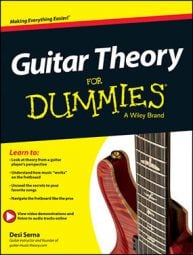The major scale is a seven-step scale that’s built using a formula of whole and half steps. You can play a major scale on the guitar by starting on any pitch and moving up in the following specified steps (W = whole step; H = half step):
W-W-H-W-W-W-H
For example, if you start on the open 6th string, the 2nd note is a whole step (two frets) higher at the 2nd fret. From there, the next note is a whole step higher at the 4th fret. Here is how to play a complete major scale by starting on the open 6th string and following the preceding pattern of whole and half steps.
![[Credit: Illustration courtesy of Desi Serna]](https://www.dummies.com/wp-content/uploads/418240.image0.jpg)
In case you’re wondering, this is the E major scale because the first note is E.
You can follow this same formula to build major scales from other starting positions, too. Here, for example, you start on F at the 1st fret of the 6th string and then on G at the 3rd fret, creating F and G major scales, respectively.
![[Credit: Illustration courtesy of Desi Serna]](https://www.dummies.com/wp-content/uploads/418241.image1.jpg)
You don’t have to play scales straight up one string as the previous examples do. On the guitar, you can play up a scale by shifting over to a higher pitched string at any point. Here are a handful of different ways to play through the G major scale.
![[Credit: Illustration courtesy of Desi Serna]](https://www.dummies.com/wp-content/uploads/418242.image2.jpg)
Each way involves playing the notes in slightly different positions, but they’re the same notes in the same scale. The step formula is the same, too, although you may have a hard time seeing this when you shift strings. (You don’t need to memorize these patterns just yet. They’re just illustrating a point.)
In addition to playing major scale notes in different positions, you can play up into higher registers. Here are a few examples. (Again, don’t worry about memorizing these at the moment.)
![[Credit: Illustration courtesy of Desi Serna]](https://www.dummies.com/wp-content/uploads/418243.image3.jpg)

